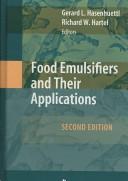| Listing 1 - 5 of 5 |
Sort by
|

ISBN: 1281275921 9786611275921 0387752846 0387752838 1441925902 Year: 2008 Publisher: New York : Springer,
Abstract | Keywords | Export | Availability | Bookmark
 Loading...
Loading...Choose an application
- Reference Manager
- EndNote
- RefWorks (Direct export to RefWorks)
Thoroughly revised and updated, the second edition of Food Emulsifiers and their Applications integrates theoretical background with practical orientation and serves as the definitive reference on subject. It offers practitioners an overview of the manufacture, analysis, physical properties, interactions and applications of emulsifiers used in processed food. Written for food technologists as well as R & D and product development personnel, begins with the design and preparation of emulsifiers (including interactions with other food ingredients), which leads in to product categories, including dairy, infant nutrition, bakery, confectionery, and margarine, followed by nutrition improvement and processing techniques. Gerard L. Hasenhuettl is a consultant in Port Saint Lucie, Florida. Richard W. Hartel is a Professor of Food Engineering in the Department of Food Science at the University of Wisconsin, Madison, Wisconsin.
Food additives. --- Dispersing agents. --- Chemical dispersants --- Dispersing chemicals --- Dispersants --- Chemicals --- Additive compounds --- Additives, Food --- Chemical additives in food --- Enriched foods --- Food science. --- Chemistry. --- Chemistry, Physical organic. --- Food Science. --- Chemistry/Food Science, general. --- Physical Chemistry. --- Physical sciences --- Science --- Chemistry, Physical organic --- Chemistry, Organic --- Chemistry, Physical and theoretical --- Food—Biotechnology. --- Physical chemistry. --- Chemistry, Theoretical --- Physical chemistry --- Theoretical chemistry --- Chemistry
Book
ISBN: 3030291871 3030291855 Year: 2019 Publisher: Cham : Springer International Publishing : Imprint: Springer,
Abstract | Keywords | Export | Availability | Bookmark
 Loading...
Loading...Choose an application
- Reference Manager
- EndNote
- RefWorks (Direct export to RefWorks)
Emulsifiers, also known as surfactants, are often added to processed foods to improve stability, texture, or shelf life. These additives are regulated by national agencies, such as the FDA, or multi-national authorities, such as the EEC or WHO. The amphiphilic molecules function by assisting the dispersion of mutually insoluble phases and stabilizing the resulting colloids, emulsions, and foams. Emulsifiers can interact with other food components such as carbohydrates, proteins, water, and ions to produce complexes and mesophases. These interactions may enhance or disrupt structures and affect functional properties of finished foods. In dairy processing, small molecule emulsifiers may displace dairy proteins from oil/water and air/water interfaces, which affects stability and properties of the foams and emulsions. In baked products, emulsifiers contribute to secondary functionalities, such as dough strengthening and anti-staling. Synthetic food emulsifiers suffer from the stigma of chemical names on a product’s ingredient statement. Modern consumers are seeking products that are “all natural.” Fortunately, there are a number of natural ingredients that are surface-active, such as lecithin, milk proteins, and some protein-containing hydrocolloids. Mayonnaise, for example, is stabilized by egg yolk. This book can serve as both a guide for professionals in the food industry to provide an understanding of emulsifier functionality, and a stimulus for further innovation. Students of food science will find this to be a valuable resource.
Microbiology. --- Food—Biotechnology. --- Physical chemistry. --- Food Microbiology. --- Food Science. --- Physical Chemistry. --- Chemistry, Theoretical --- Physical chemistry --- Theoretical chemistry --- Chemistry --- Microbial biology --- Biology --- Microorganisms --- Food additives. --- Additive compounds --- Additives, Food --- Chemical additives in food --- Enriched foods --- Tecnologia dels aliments --- Enginyeria alimentària --- Enginyeria d'indústries alimentàries --- Enginyeria dels aliments --- Tecnologia alimentària --- Tecnologia d'aliments --- Tecnologia --- Additius alimentaris --- Biotecnologia alimentària --- Microbiologia dels aliments --- Aliments --- Begudes --- Indústria alimentària

ISBN: 9780387752846 Year: 2008 Publisher: New York, NY Springer Science+Business Media, LLC
Abstract | Keywords | Export | Availability | Bookmark
 Loading...
Loading...Choose an application
- Reference Manager
- EndNote
- RefWorks (Direct export to RefWorks)
Physicochemistry --- Food science and technology --- voedingschemie --- voedingstechnologie --- voedingsleer --- fysicochemie

ISBN: 9780387752846 Year: 2008 Publisher: New York, NY Springer Science+Business Media, LLC
Abstract | Keywords | Export | Availability | Bookmark
 Loading...
Loading...Choose an application
- Reference Manager
- EndNote
- RefWorks (Direct export to RefWorks)
Thoroughly revised and updated, the second edition of Food Emulsifiers and their Applications integrates theoretical background with practical orientation and serves as the definitive reference on subject. It offers practitioners an overview of the manufacture, analysis, physical properties, interactions and applications of emulsifiers used in processed food. Written for food technologists as well as R & D and product development personnel, begins with the design and preparation of emulsifiers (including interactions with other food ingredients), which leads in to product categories, including dairy, infant nutrition, bakery, confectionery, and margarine, followed by nutrition improvement and processing techniques. Gerard L. Hasenhuettl is a consultant in Port Saint Lucie, Florida. Richard W. Hartel is a Professor of Food Engineering in the Department of Food Science at the University of Wisconsin, Madison, Wisconsin.
Physicochemistry --- Food science and technology --- voedingschemie --- voedingstechnologie --- voedingsleer --- fysicochemie
Book
ISBN: 9783030291877 Year: 2019 Publisher: Cham Springer International Publishing :Imprint: Springer
Abstract | Keywords | Export | Availability | Bookmark
 Loading...
Loading...Choose an application
- Reference Manager
- EndNote
- RefWorks (Direct export to RefWorks)
| Listing 1 - 5 of 5 |
Sort by
|

 Search
Search Feedback
Feedback About UniCat
About UniCat  Help
Help News
News